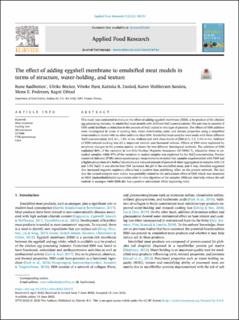| dc.contributor.author | Rødbotten, Rune | |
| dc.contributor.author | Böcker, Ulrike | |
| dc.contributor.author | Høst, Vibeke | |
| dc.contributor.author | Dankel, Elin Katinka | |
| dc.contributor.author | Sanden, Karen Wahlstrøm | |
| dc.contributor.author | Pedersen, Mona Elisabeth | |
| dc.contributor.author | Ofstad, Ragni | |
| dc.date.accessioned | 2022-06-28T07:19:36Z | |
| dc.date.available | 2022-06-28T07:19:36Z | |
| dc.date.created | 2022-06-27T13:42:58Z | |
| dc.date.issued | 2022 | |
| dc.identifier.issn | 2772-5022 | |
| dc.identifier.uri | https://hdl.handle.net/11250/3001194 | |
| dc.description.abstract | This study was conducted to evaluate the effect of adding eggshell membrane (ESM), a by-product of the chicken egg processing industry, to emulsified meat models with different NaCl concentrations. The aim was to examine if ESM could facilitate a reduction in the amount of NaCl added to this type of product. The effects of ESM addition were investigated in terms of cooking loss, water distribution, color, and texture properties using a simplified meat emulsion model with no other additives than ESM. Emulsified meat samples were made with three different NaCl concentrations (0.5, 0.1, 1.5% w/w), without and with three levels of ESM (0.5, 1.0, 1.5% w/w). Addition of ESM reduced cooking loss (CL), improved texture, and increased redness. Effects of ESM were explained by structural changes in the protein matrix, as shown by two different histological methods. The addition of ESM explained 86% of the variation in low-field Nuclear Magnetic Resonance (LF-NMR) T2 relaxation times in uncooked samples, while 97% of the variation in cooked samples was explained by the NaCl concentration. Fourier transform Infrared (FTIR) micro-spectroscopic measurements revealed that samples supplemented with ESM had a higher proportion of α-helical structures and reduced amount of protein ß-sheet aggregation in samples with 1.0 and 1.5% NaCl. It was shown that ESM increased the pH of the emulsified meat, and it was, therefore suggested that increased negative repulsion effects had a positive heat stabilizing effect on the protein network. The fact that the cooked samples were redder was probably related to the antioxidant effect of ESM which was measured as MDA (malondialdehyde) equivalents after in vitro digestion of the samples. ESM can thus help reduce the salt content in sausages while ESM also has a positive antioxidant effect improving color. | |
| dc.description.abstract | The effect of adding eggshell membrane to emulsified meat models in terms of structure, water-holding, and texture | |
| dc.language.iso | eng | en_US |
| dc.subject | FTIR spectroscopy | |
| dc.subject | FTIR-spectroscopy | |
| dc.subject | Mikrostruktur | |
| dc.subject | Microstructure | |
| dc.subject | Cooking loss | |
| dc.subject | Cooking loss | |
| dc.subject | Meat emulsions | |
| dc.subject | Meat emulsions | |
| dc.subject | LF NMR | |
| dc.subject | LF-NMR | |
| dc.title | The effect of adding eggshell membrane to emulsified meat models in terms of structure, water-holding, and texture | en_US |
| dc.title.alternative | The effect of adding eggshell membrane to emulsified meat models in terms of structure, water-holding, and texture | en_US |
| dc.type | Journal article | en_US |
| dc.description.version | publishedVersion | |
| dc.source.volume | 2 | en_US |
| dc.source.journal | Applied Food Research | en_US |
| dc.identifier.doi | 10.1016/j.afres.2022.100151 | |
| dc.identifier.cristin | 2035435 | |
| dc.relation.project | Nofima AS: 202102 | |
| dc.relation.project | Norges forskningsråd: 314599 | |
| dc.relation.project | Nofima AS: 202101 | |
| dc.relation.project | Norges forskningsråd: 314318 | |
| dc.relation.project | Norges forskningsråd: 314111 | |
| dc.relation.project | Nofima AS: 202103 | |
| cristin.ispublished | true | |
| cristin.fulltext | original | |
